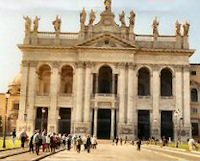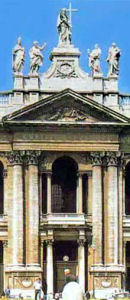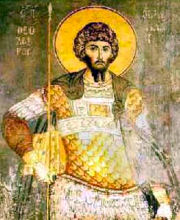
Daily Readings for:November 09, 2013
(Readings on USCCB website)
Collect: O God, who from living and chosen stones prepare an eternal dwelling for your majesty, increase in your Church the spirit of grace you have bestowed, so that by new growth your faithful people may build up the heavenly Jerusalem. Through our Lord Jesus Christ, your Son, who lives and reigns with you in the unity of the Holy Spirit, one God, for ever and ever.
RECIPES
ACTIVITIES
o Praying for the Dead and Gaining Indulgences During November
o Religion in the Home for Elementary School: November
o Religion in the Home for Preschool: November
o Teaching Children About Sickness and Death
PRAYERS
o November Devotion: The Holy Souls in Purgatory
o Little Litany of the Holy Souls
· Ordinary Time: November 9th
· Feast of the Dedication of St. John Lateran Basilica
Old Calendar: Dedication of the Archbasilica of Our Holy Savior; St. Theodore, martyr
Today the Church celebrates the feast of the Dedication of the Lateran Basilica in Rome. The Basilica of St. John Lateran is the cathedral of Rome. This is not St. Peter's, but it is the Pope's cathedral. Also called the Church of Holy Savior or the Church of St. John Baptist, it was the baptism church of ancient Rome. It was built in the time of Constantine and was consecrated by Pope Sylvester in 324. This feast became a universal celebration in honor of the basilica called "the mother and mistress of all churches of Rome and the world" (omnium urbis et orbis ecclesiarum mater et caput) as a sign of love for and union with the See of Peter.
According to the 1962 Missal of Bl. John XXIII the Extraordinary Form of the Roman Rite, today is the commemoration of St. Theodore, a Christian soldier and martyr of Asia Minor.
The Temple of Stones is a Symbol of the Living Church
Today the liturgy celebrates the dedication of the Lateran Basilica, called “mother and head of all the churches of the city and the world.” In fact, this basilica was the first to be built after Emperor Constantine’s edict, in 313, granted Christians freedom to practice their religion.
The emperor himself gave Pope Miltiades the ancient palace of the Laterani family, and the basilica, the baptistery, and the patriarchate, that is, the Bishop of Rome’s residence — where the Popes lived until the Avignon period — were all built there. The basilica’s dedication was celebrated by Pope Sylvester around 324 and was named Most Holy Savior; only after the 6th century were the names of St. John the Baptist and St. John the Evangelist added, and now is typically denominated by these latter.
Initially the observance of this feast was confined to the city of Rome; then, beginning in 1565, it was extended to all the Churches of the Roman rite. The honoring of this sacred edifice was a way of expressing love and veneration for the Roman Church, which, as St. Ignatius of Antioch says, “presides in charity” over the whole Catholic communion (Letter to the Romans, 1:1).
On this solemnity the Word of God recalls an essential truth: the temple of stones is a symbol of the living Church, the Christian community, which in their letters the Apostles Peter and Paul already understood as a “spiritual edifice,” built by God with “living stones,” namely, Christians themselves, upon the one foundation of Jesus Christ, who is called the “cornerstone” (cf. 1 Corinthians 3:9-11, 16-17; 1 Peter 2:4-8; Ephesians 2:20-22). “Brothers, you are God’s building,” St. Paul wrote, and added: “holy is God’s temple, which you are” (1 Corinthians 3:9c, 17).
The beauty and harmony of the churches, destined to give praise to God, also draws us human beings, limited and sinful, to convert to form a “cosmos,” a well-ordered structure, in intimate communion with Jesus, who is the true Saint of saints. This happens in a culminating way in the Eucharistic liturgy, in which the “ecclesia,” that is, the community of the baptized, come together in a unified way to listen to the Word of God and nourish themselves with the Body and Blood of Christ. From these two tables the Church of living stones is built up in truth and charity and is internally formed by the Holy Spirit transforming herself into what she receives, conforming herself more and more to the Lord Jesus Christ. She herself, if she lives in sincere and fraternal unity, in this way becomes the spiritual sacrifice pleasing to God.
Dear friends, today’s feast celebrates a mystery that is always relevant: God’s desire to build a spiritual temple in the world, a community that worships him in spirit and truth (cf. John 4:23-24). But this observance also reminds us of the importance of the material buildings in which the community gathers to celebrate the praises of God. Every community therefore has the duty to take special care of its own sacred buildings, which are a precious religious and historical patrimony. For this we call upon the intercession of Mary Most Holy, that she help us to become, like her, the “house of God,” living temple of his love.
— Benedict XVI, Angelus Address, November 9, 2008
Things to Do:
- Learn more about St. John Lateran;
- This basilica represents the place of baptism, so it would be a good time to renew your baptismal promises;
- It also represents heaven, so we can meditate on the joys of heaven and God's generosity in giving us sufficient graces to be saved;
- Since St. John Lateran is the Pope's church, say a prayer for our Holy Father;
- From the Catholic Culture Library: Mother Church of the World.
St. Theodore
St. Theodore was a Christian soldier who set on fire the temple of the mother-goddess Cybele at Amasea (303 A.D.). The prefect of the legion promised mercy if he repented his act and renounced the Christian faith. Theodore persevered bravely; accordingly he was cast into prison and his flesh ripped by iron hooks so that his ribs were exposed. In the midst of indescribable torture he sang joyfully, "I will bless the Lord at all times; His praise will ever be in my mouth" (Ps. 33).
Praying and singing the glories of Christ, he was burned alive on November 9. A panegyric by St. Gregory of Nyssa on his virtues is extant. Theodore's head has been venerated at Cajeta since the Middle Ages. In ancient times, particularly among the Greeks, this soldier-martyr was honored as patron of armies. During the seventh century a church was dedicated to him in Rome, and his picture appears upon the apse mosaic in the church of Sts. Cosmas and Damian.
Excerpted from The Church's Year of Grace, Pius Parsch
Symbols: Post and iron hooks; white horse; temple of Cybele in flames; crown of thorns; cross; Roman armour; sword.
Things to Do:
- Well might we marvel at the heroic courage St. Theodore showed in the midst of pain. While suffering horribly he sang songs of praise! And we are so frightened by the smallest ache and become uncomfortable at the very mention of suffering! God does not ask such suffering from us as He did from Theodore, yet He asks that we accept some troubles patiently. If we have any discomfort today, let us offer it up without complaint;
- Also, remember our soldiers and say a prayer for them;
- Read what St. Gregory of Nyssa wrote about St. Theodore.